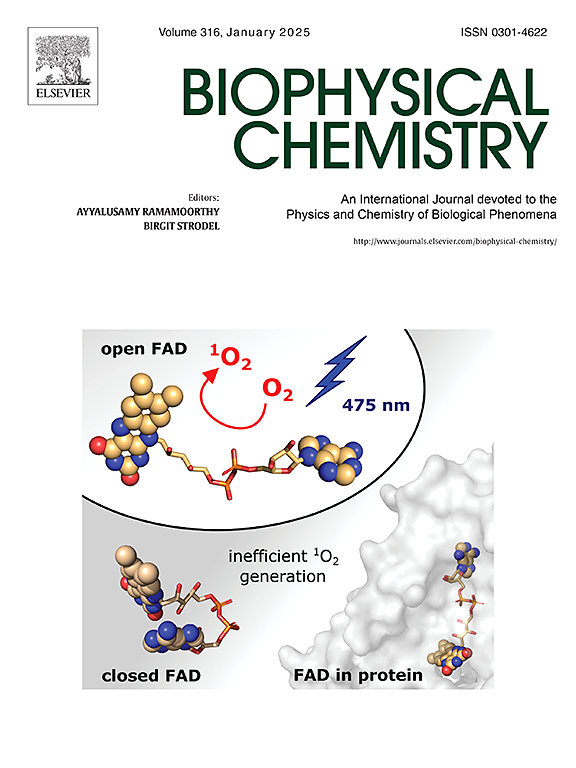Relevance of ceramide 1-phosphate domain formation in activation of cytosolic phospholipase A2
IF 2.2
3区 生物学
Q2 BIOCHEMISTRY & MOLECULAR BIOLOGY
引用次数: 0
Abstract
Ceramide 1-phosphate (C1P), as a lipid mediator, specifically binds and activates cytosolic phospholipase A2α (cPLA2α). Previous findings revealed that modification of the specific hydrophobic moiety decreases the affinity with cPLA2α. However, the possible biological role of the temporal C1P-enriched domains formed in biomembranes for the molecular recognition of cPLA2α has not been fully elucidated. In this study we elucidated the properties of segregated domains formed by C1P (and its analogs) and the affinity of cPLA2α for C1P in different co-lipid environments by fluorescence spectroscopy using trans-parinaric acid and surface plasmon resonance (SPR). Fluorescence measurements suggested that the formation of C1P ordered domains is strongly influenced by interfacial 3-OH and phosphate groups of C1P, such as hydrogen-bonding and electrostatic interactions, and depends on the co-lipid composition of the host bilayer. SPR indicated that C1P under the lipid environment favorable for the formation of C1P clusters has higher affinity for cPLA2α. Thus, we speculate that C1P clusters formed under certain membrane conditions are important in specific binding with cPLA2α by increasing the interaction between the C1P headgroup and basic residues of cPLA2α. In conclusion, this study revealed that the local formation of lipid mediator-rich clusters in biomembranes likely has a significant effect on the interaction between the mediator and its receptor protein.

神经酰胺1-磷酸结构域形成与胞质磷脂酶A2激活的相关性
神经酰胺1-磷酸(C1P)作为一种脂质介质,特异性结合并激活胞质磷脂酶A2α (cPLA2α)。先前的研究结果表明,特定疏水片段的修饰降低了与cPLA2α的亲和力。然而,生物膜中形成的时间型c1p富集结构域在cPLA2α分子识别中的可能生物学作用尚未完全阐明。本研究利用反式粒子酸和表面等离子体共振(SPR)荧光光谱分析了C1P(及其类似物)形成的分离结构域的性质,以及cPLA2α在不同共脂环境下对C1P的亲和力。荧光测量表明,C1P有序结构域的形成受到C1P的界面3-OH和磷酸基团(如氢键和静电相互作用)的强烈影响,并取决于宿主双分子层的共脂质组成。SPR结果表明,在有利于形成C1P簇的脂质环境下,C1P对cPLA2α具有较高的亲和力。因此,我们推测在一定的膜条件下形成的C1P簇通过增加C1P头基与cPLA2α基本残基之间的相互作用,在与cPLA2α的特异性结合中起重要作用。综上所述,本研究揭示了生物膜中富含脂质介质簇的局部形成可能对介质与其受体蛋白的相互作用有重要影响。
本文章由计算机程序翻译,如有差异,请以英文原文为准。
求助全文
约1分钟内获得全文
求助全文
来源期刊

Biophysical chemistry
生物-生化与分子生物学
CiteScore
6.10
自引率
10.50%
发文量
121
审稿时长
20 days
期刊介绍:
Biophysical Chemistry publishes original work and reviews in the areas of chemistry and physics directly impacting biological phenomena. Quantitative analysis of the properties of biological macromolecules, biologically active molecules, macromolecular assemblies and cell components in terms of kinetics, thermodynamics, spatio-temporal organization, NMR and X-ray structural biology, as well as single-molecule detection represent a major focus of the journal. Theoretical and computational treatments of biomacromolecular systems, macromolecular interactions, regulatory control and systems biology are also of interest to the journal.
 求助内容:
求助内容: 应助结果提醒方式:
应助结果提醒方式:


